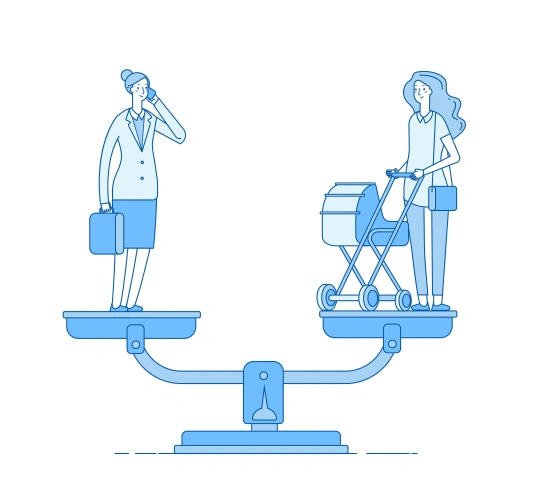19 Techniques to Improve Work Life Balance
Work life balance is essential to ensure sanity, and long-term productivity and prosperity, not just for employees but for companies. Bright and wise leaders realize that poor leaders think that they may continue loading their staff with more and more responsibilities.
In this article, you will find out about 19 techniques that you can use to improve work life balance.
1. Establish Your “Work Life Balance Policy”
First and foremost, decide for yourself what is important for you. First, decide about the extremes – whether you live to work, or you work to live.
After that, determine what will be your “policy” or the overall approach to how you make decisions on whether to work or have a life. This may be as simple as “no professional calls after 5 pm”.

No answer is wrong, as it is your life and your decision. Sometimes, especially earlier in our careers, it is necessary to spend more time at work to gain competencies, experience, and expertise.
However, that shouldn’t turn into a blind habit, where we spend a lot of extra time at work just because “it has always been this way.”
Make a decision about what is important for you at the present time in your life. And communicate the decision to your family and friends to make sure that they support you.
But do keep in mind, that the time is precious, and you can’t get it back.
2. Have a Strong Willpower to Stick to Your “Policy”
After you have determined the rules for the work-life balance – you need to have strong willpower and stick to them.
If you slip once or make an exception once for your colleague who is begging for your help after hours, the overall system established by your work-life “policy” will lose its relevance.
The presence of after-hours calls, escalations, or issues that need to be addressed right away “or else the world will fall apart” are symptoms of larger organizational issues that you won’t be able to solve on that specific evening.
Rather, look at the types of systemic issues that you may have in your area, and rather than spending your 9-5 in firefighting, see if you can start to address the root causes that generated these issues proactively.
You need to be aware of small things that may creep into your work-life “policy,” such as a temptation to check office emails on your phone while at lunch. While this behavior may seem insignificant, it skews your “moral compass” that helps you to maintain adherence to your work-life balance “policy.”
3. Avoid Multitasking
Most of us think that we are great multitaskers. We praise ourselves for multitasking, on how many projects can we manage in parallel, and how many tasks we can accomplish. In truth, we are deceiving ourselves.
As per the study of the American Psychological Association, only 2% of people are good at multitasking.
The reason why we want to avoid multitasking is that in-between of every task, there is a switching time between one task and another.
While that time may be completely negligent and tiny, cumulatively – that time contributes to a very significant drain in productivity and an added pressure on our attention span.
Over time, switching costs can translate into hours and days of lost productivity, which you may be tempted to compensate for with your personal time and at your personal expense.
You shouldn’t do that on a one-off basis, but rather – go back and fix the root cause.
4. Beware of Cost of Time
Quite often, some individuals are not aware of their cost of time. They don’t think that their time outside of work has at least the same price as at work, or even higher.
If you are an entrepreneur – you can spend every minute of your day looking for attractive business ideas and working on implementing them to achieve profitability.
That tie with the profitability is missing quite often. Someone may drive for 1 hour to the store to return a $10 item and then drive for another hour back.
This has just resulted in their ROI being $5 per hour. And it is not even ROI; it is cost recovery.

Much the same way, if you are pursuing an objective that will bring you $100 dollars, and you have spent 1 hour on it and completed successfully – your hourly rate is $100/hr.
If you spent 10 hours to achieve that same task, your per-hour rate is $10.
When you value your time both at work and outside of work, you build a strong connection between the effort and the reward that comes as a result of that effort.
When you pay more attention – you will see that suddenly, tasks are not occupying all the free time for some unknown reason, but rather, you are in control of how much time you spend and on what.
And that decision is fully yours, that you can make based on your work or life priorities to achieve even better work-life balance.
5. Have an Up to Date Schedule
When you have many things on the goal, it often helps to have a good schedule. In your schedule, include all of your priorities and activities that have any time-related sensitivity.
By seeing all of your to-do items on your calendar, you know what exactly you need to do and by when. And this doesn’t just cover professional items; if you have a busy personal life – utilize the same technique.

Schedule your time, and you will start gaining clarity regarding what it is that you need to work on next. This way, ad-hoc tasks, requests, trips to the store, and many other items that have a habit of coming up without any notice will have a proper place in your calendar and the right time to accomplish them.
You will know when to work on “work” items and when on “personal” items.
6. Batch Things
Rather than accomplishing things one by one and having an either switching costs, or the travel time in between the tasks, see if you can batch what you do, and do it less often, but with a bigger size of the batch.
For example, you don’t want to visit a grocery store every day, but rather, build and maintain a list of what you need to buy, and do it once a week.
7. Master the Selective Ignorance
Prioritization itself is not enough to achieve successful results. Before you start putting everything you need to filter out the work as you do not have to work on all of the tasks that have come your way.

Not everything under the sun needs your attention.
The members of your team are fully competent to take care of the majority of the tasks on their plate, and they know the circumstances when they should reach out to you for help.
8. Be Organized
The opposite of being organized is chaos. When your workplace, your life, or your mind is in a state of chaos, not many good things can be accomplished.
That happens because every single distraction competes for your attention span, rendering you completely incapable of paying attention to all of them, let alone the main activity that you need to accomplish to get to your objective.
Organizing not only your workplace but your workflow will lead to improved productivity, and ultimately – to a better work-life balance.
9. Make Your Availability Clear
Make it clear for others when you are available and for what. Add some degree of structure so that you are not approached on an ad-hoc basis on all topics all the time.
You may want to establish Mondays as your escalation day, Tuesdays as planning day, Wednesdays may be your day for meetings, Thursdays – a day for the “open door” policy, and Friday – for team building and knowledge sharing activities.
10. Establish Boundaries
Let others know what is acceptable and what is not acceptable in terms of their behavior.
This is especially important for contacts and escalations after work. Let your team about what kind of issues they can contact you for and which others should wait till the next day.
By establishing boundaries, you are controlling the external pressures, for example, when someone from your office is calling while you are having dinner with your family.

The first time, it may not be a big deal, the second time it happens, it may start bothering you, and the third time – you may be ready to boil.
Don’t get the interactions to the boiling point; communicate the desired behaviors in advance.
11. Socialize
When you are in social isolation, you may feel that the work is the best way and one of the only meaningful ways to fill your time. It is neither.
You have a lot more talents, hobbies, and friends around you to unconsciously dedicate yourself to work.
Go through your address book, is there a friend whom you haven’t talked to in a while? Perhaps it is time to pick up a phone and socialize with them a bit?
They may be in the same situation as you are, and together – you will make each others’ day a bit brighter.
Get into a habit of seeing people outside of work and outside of the professional circle. While social media provides a way to keep in touch, to socialize properly – you need to see them in person.
Think of something exciting that both of you can do together, that both of you enjoy.

By having a collective experience, your friendship will grow stronger.
One of the socialization pitfalls is, “let’s go for a beer with the guys from work after work.” You have limited time. Ask yourself if you want to bring work relationships into your personal life.
For some, you might, and some co-workers may become great friends. But that happens not because of the “beer after work,” but for other more profound reasons.
12. Be Clear in Your Communication
When you don’t have clarity in your communication with other people, they need to touch base with you and confirm what exactly you may want from them. When you communicate clearly, they don’t need to guess what exactly is it that you need from them and second guess how they should accomplish that.
When there is less rework, your productivity is higher, and there are fewer things that are creeping into your personal life from your work life.
13. Let Other People Know Your Communication Preferences
When you let others know how you like to receive the information, in which format, and with which frequency, you will have more relevant information on a more timely basis.
You will not need to spend as much time chasing down the information and those that are responsible for producing it.
This will also help you to draw a line between your personal and professional life.
14. Have Long Term and Short Term Goals
When you are establishing your objectives upfront, you should ensure that the objectives are achievable so that you can adhere to them.
Well-crafted objectives and activities will bring you closer to your goals. This remains true not just for professional goals but for your goals outside of work.

To be achieved, all goals must be planned well in advance; otherwise, they may occupy all of the available time while slowing down the progress to nearly a standstill.
15. Block Your Time
When you block your time in your calendar for personal or professional activities, you make sure that you have uninterrupted time.
This helps you to maintain sanity, mental composure, and during that time – you know that you will be able to focus on what is needed for that task, rather than being torn into multiple directions while unable to focus on one thing at a time.
16. Say “No” More Often
If you feel overwhelmed, and yet, more work is coming your way to upset a fragile work-life balance, it is okay to say “no.” You do not have to say it confrontationally, and you can use “no” with various modifiers, such as “not right now, but I can do it in a week.”
When you control the volume and velocity of the upcoming challenges that require your attention in the workplace, you are freeing up your schedule to focus on what is important.
17. Allocate Staff at 80%
If you allocate staff members to tasks, beware of their productive capacity. While they may be allocated at 100% to a task, quite often, it is not an actual time that they can spend on the task.

They may have team meetings, meetings with their manager (or you), various team-building activities, and many other tasks that take time.
If you account for all of that and allocate your staff that is available on a full-time basis at 80% of the capacity, you will see improved productivity.
18. Praise Others For Their Dedication to Family
Quite often, when my staff brings up family affairs, I like to say “family is the most important” for them not to feel bad as if they are asking for my permission to have family time on their mind, by emphasizing the importance of family and the personal aspect while at work, you create the environment where there is a focus on balance right from the start.
Within such an environment, team members will put forward their absolute best because they know, when they urgently need time to spend with their family – it will not be an issue at their work.
19. Ensure Consistency
When you don’t just establish the work-life balance guidelines for yourself once, but still with them until your habits are formed – you will anchor your behaviors.

That usually takes at least one month of consistency. Don’t expect the deeply rooted changes to happen overnight. They will, but your internal “wiring” (your mind and your body) need to be accustomed to how does it feel to have a new habit.
After you achieve consistency in making work-life balance choices, you will make the decisions in a way that supports your chosen work-life balance “policy.”
Conclusion
By establishing your overall approach, or a “policy” towards how you are looking at a work-life balance, you ensure that you are consistent with what is important for you at the present time in your personal and your professional life.
After you have established this work-life balance “policy,” stick with it, and build your own behaviors and communicate the expectations for others to know what is important for you, how do you want to be treated, and what kind of work-life balance would you like to have.
Take Action!
Start Improving Your Business Today!
Need our help in helping your business to grow?
About the Author

Eugen Spivak is a multi-award-winning author, business strategist, and a business coach. Eugen is the founder of the Canadian Institute of International Business, an organization dedicated to bringing practical and hands-on business education for modern business leaders.


